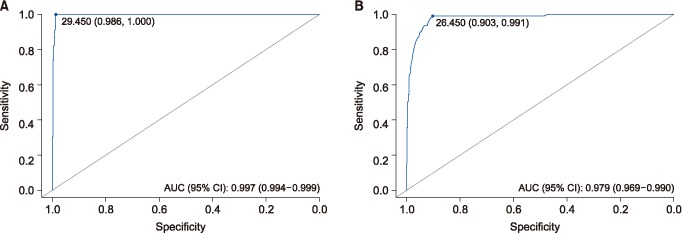J Menopausal Med.
2019 Apr;25(1):55-62. 10.6118/jmm.2019.25.1.55.
The Efficacy of Body Mass Index and Total Body Fat Percent in Diagnosis Obesity according to Menopausal Status
- Affiliations
-
- 1Department of Obstetrics and Gynecology, Pusan National University School of Medicine and Medical Research Institute, Pusan National University Hospital, Busan, Korea. jongkilj@hanmail.net
- KMID: 2443628
- DOI: http://doi.org/10.6118/jmm.2019.25.1.55
Abstract
OBJECTIVES
Body mass index (BMI) is commonly used in epidemiological study or clinical center. However, it is not exactly correlated with body fat composition and does not reflect sex, age, or race. The aim of this article is to evaluate the validity of BMI standards relative to total body fat (TBF) and to estimate new BMI criteria that correspond to TBF for obesity, especially for Asian postmenopausal women.
METHODS
A total 3,936 patients were included in this cross-sectional study, including 1,565 premenopausal and 2,371 postmenopausal women. At the time of visit, demographic data were collected. We demonstrated the validity of BMI cut-point of 25 kg/m2 by using area under the curve (AUC), and presented the empirical optimal BMI cut-point by using Youden's index and overall accuracy in both premenopausal and postmenopausal women.
RESULTS
BMI-defined obesity (≥ 25 kg/m2) represents high AUC values (> 0.9) for each TBF. In premenopausal women, TBF ≥ 38% and corresponding BMI value was 29.45 kg/m2 indicated the highest both Youden's index and overall accuracy. In comparison, postmenopausal women who were TBF ≥ 38% showed the highest Youden's index and overall accuracy, and corresponding BMI value was 26.45 kg/m2.
CONCLUSIONS
We proposed new BMI criteria for obesity by using TBF reference. With application of bioelectrical impedance analysis, the diagnosis of obesity using BMI criteria may differ between premenopausal and postmenopausal women.
Keyword
MeSH Terms
Figure
Reference
-
1. Malnick SD, Knobler H. The medical complications of obesity. QJM. 2006; 99:565–579. PMID: 16916862.
Article2. Sharma N, Natung T, Barooah R, Ahanthem SS. Effect of multiparity and prolonged lactation on bone mineral density. J Menopausal Med. 2016; 22:161–166. PMID: 28119896.
Article3. World Health Organization (WHO). Physical status: the use and interpretation of anthropometry. Geneva: WHO;1995. Report No.: WHO Technical Report Series 854.4. Joo JK, Lee KS. Pharmacotherapy for obesity. J Menopausal Med. 2014; 20:90–96. PMID: 25580419.
Article5. Kuk JL, Saunders TJ, Davidson LE, Ross R. Age-related changes in total and regional fat distribution. Ageing Res Rev. 2009; 8:339–348. PMID: 19576300.
Article6. Shobeiri F, Jenabi E, Poorolajal J, Hazavehei SM. The association between body mass index and hot flash in midlife women: a meta-analysis. J Menopausal Med. 2016; 22:14–19. PMID: 27152309.
Article7. Lizcano F, Guzmán G. Estrogen deficiency and the origin of obesity during menopause. Biomed Res Int. 2014; 2014:757461. PMID: 24734243.
Article8. National Institute of Health (NIH). NHLBI Obesity Education Initiative. National Heart, Lung, and Blood Institute. North American Association for the Study of Obesity. The practical guide: identification, evaluation, and treatment of overweight and obesity in adults. Bethesda: NIH Publication;2000.9. Jensen MD, Ryan DH, Apovian CM, Ard JD, Comuzzie AG, Donato KA, et al. 2013 AHA/ACC/TOS guideline for the management of overweight and obesity in adults: a report of the American College of Cardiology/American Heart Association Task Force on Practice Guidelines and The Obesity Society. J Am Coll Cardiol. 2014; 63:2985–3023. PMID: 24239920.10. Jee SH, Sull JW, Park J, Lee SY, Ohrr H, Guallar E, et al. Body-mass index and mortality in Korean men and women. N Engl J Med. 2006; 355:779–787. PMID: 16926276.
Article11. Kim MK, Lee WY, Kang JH, Kang JH, Kim BT, Kim SM, et al. 2014 clinical practice guidelines for overweight and obesity in Korea. Endocrinol Metab (Seoul). 2014; 29:405–409. PMID: 25559568.
Article12. Verney J, Schwartz C, Amiche S, Pereira B, Thivel D. Comparisons of a multi-frequency bioelectrical impedance analysis to the dual-energy X-Ray absorptiometry scan in healthy young adults depending on their physical activity level. J Hum Kinet. 2015; 47:73–80. PMID: 26557191.
Article13. Kim CH, Park HS, Park M, Kim H, Kim C. Optimal cutoffs of percentage body fat for predicting obesity-related cardiovascular disease risk factors in Korean adults. Am J Clin Nutr. 2011; 94:34–39. PMID: 21525205.
Article14. Chang CJ, Wu CH, Yao WJ, Yang YC, Wu JS, Lu FH. Relationships of age, menopause and central obesity on cardiovascular disease risk factors in Chinese women. Int J Obes Relat Metab Disord. 2000; 24:1699–1704. PMID: 11126227.
Article15. Šimundić AM. Measures of diagnostic accuracy: basic definitions. EJIFCC. 2009; 19:203–211. PMID: 27683318.16. Banack HR, Wactawski-Wende J, Hovey KM, Stokes A. Is BMI a valid measure of obesity in postmenopausal women? Menopause. 2018; 25:307–313. PMID: 29135897.
Article17. Sun G, French CR, Martin GR, Younghusband B, Green RC, Xie YG, et al. Comparison of multifrequency bioelectrical impedance analysis with dual-energy X-ray absorptiometry for assessment of percentage body fat in a large, healthy population. Am J Clin Nutr. 2005; 81:74–78. PMID: 15640463.
Article18. Rockamann RA, Dalton EK, Arabas JL, Jorn L, Mayhew JL. Validity of arm-to-arm BIA devices compared to DXA for estimating % fat in college men and women. Int J Exerc Sci. 2017; 10:977–988. PMID: 29170699.19. Ranasinghe C, Gamage P, Katulanda P, Andraweera N, Thilakarathne S, Tharanga P. Relationship between body mass index (BMI) and body fat percentage, estimated by bioelectrical impedance, in a group of Sri Lankan adults: a cross sectional study. BMC Public Health. 2013; 13:797. PMID: 24004464.
Article
- Full Text Links
- Actions
-
Cited
- CITED
-
- Close
- Share
- Similar articles
-
- Dietary Intake, Serum Lipids, Iron Index and Antioxidant Status by Percent Body Fat of Young Females
- The Study of Body Fat Percent Measured by Bioelectric Impedance Analyzer in a Rural Adult Population
- Correlation between Body Fat Percent Estimated by Bioelectrical Impedance Analysis and Other Variable Methods
- Difference of the Obesity Index, Blood Pressure and Serum Lipids in Abdominal and Non Abdominal in Men and Women
- Association of Body Fat and Body Mass Index with Pulmonary Function in Women in Their Forties


